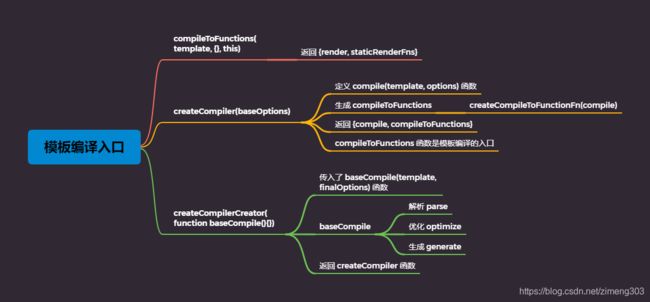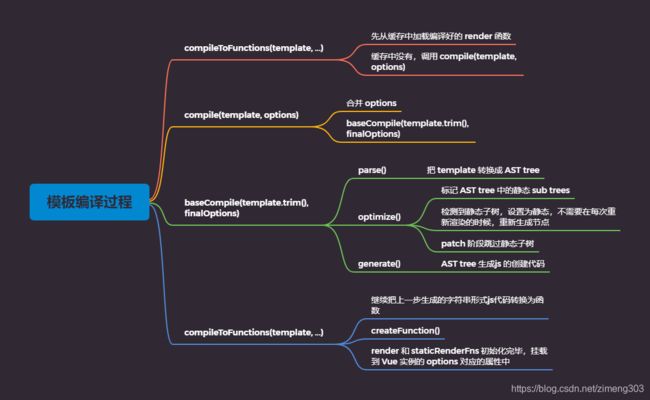【Vue.js源码解析 三】-- 模板编译和组件化
前言
笔记来源:拉勾教育 大前端高薪训练营
阅读建议:建议通过左侧导航栏进行阅读
模板编译
-
模板编译的主要目的是将模板 (template) 转换为渲染函数 (render)
<div> <h1 @click="handler">titleh1> <p>some contentp> div> -
渲染函数 render
render (h) { return h('div', [ h('h1', { on: { click: this.handler} }, 'title'), h('p', 'some content') ]) } -
模板编译的作用
- Vue 2.x 使用 VNode 描述视图以及各种交互,用户自己编写 VNode 比较复杂
- 用户只需要编写类似 HTML 的代码 - Vue 模板,通过编译器将模板转换为返回 VNode 的 render 函数
- .vue 文件会被 webpack 在构建的过程中转换成 render 函数
体验模板编译的结果
-
带编译器版本的 Vue.js 中,使用 template 或 el 的方式设置模板
<div id="app"> <h1>Vue<span>模板编译过程span>h1> <p>{{ msg }}p> <comp @myclick="handler">comp> div> <script src="../../dist/vue.js">script> <script> Vue.component('comp', { template: 'I am a comp' }) const vm = new Vue({ el: '#app', data: { msg: 'Hello compiler' }, methods: { handler () { console.log('test') } } }) console.log(vm.$options.render) script> -
编译后 render 输出的结果
(function anonymous() { with (this) { return _c( "div", { attrs: { id: "app" } }, [ _m(0), _v(" "), _c("p", [_v(_s(msg))]), _v(" "), _c("comp", { on: { myclick: handler } }), ], 1 ); } }); -
_c是createElement()方法,定义的位置 instance/render.js 中_ -
相关的渲染函数(_开头的方法定义),在 instance/render-helps/index.js 中
src/core/instance/render-helps/index.js
// 创建文本 Vnode target._v = createTextVNode // 处理静态内容 target._m = renderStaticsrc/core/vdom/vnode.js
export function createTextVNode (val: string | number) { return new VNode(undefined, undefined, undefined, String(val)) }src/core/instance/render-helps/render-static.js
/** * Runtime helper for rendering static trees. */ export function renderStatic ( index: number, isInFor: boolean ): VNode | Array<VNode> { const cached = this._staticTrees || (this._staticTrees = []) let tree = cached[index] // if has already-rendered static tree and not inside v-for, // we can reuse the same tree. if (tree && !isInFor) { return tree } // otherwise, render a fresh tree. tree = cached[index] = this.$options.staticRenderFns[index].call( this._renderProxy, null, this // for render fns generated for functional component templates ) markStatic(tree, `__static__${index}`, false) return tree } -
把 template 转换成 render 的入口 src\platforms\web\entry-runtime-with-compiler.js
Vue Template Explorer
-
vue-template-explorer
-
Vue 2.6 把模板编译成 render 函数的工具
-
vue-next-template-explorer
-
Vue 3.0 beta 把模板编译成 render 函数的工具
模板编译过程
- 解析、优化、生成
编译的入口
-
src\platforms\web\entry-runtime-with-compiler.jsVue.prototype.$mount = function ( // el: 创建 vue 实例时,传入的选项 el?: string | Element, // 非 SSR 情况下为 false,SSR 时为 true hydrating?: boolean ): Component { ...... // 把 template 转换成 render 函数 const { render, staticRenderFns } = compileToFunctions(template, { outputSourceRange: process.env.NODE_ENV !== 'production', shouldDecodeNewlines, shouldDecodeNewlinesForHref, delimiters: options.delimiters, comments: options.comments }, this) options.render = render options.staticRenderFns = staticRenderFns ...... } -
调试 compileToFunctions() 执行过程,生成渲染函数的过程
-
compileToFunctions: src\compiler\to-function.js -
complie(template, options):src\compiler\create-compiler.js -
baseCompile(template.trim(), fifinalOptions):src\compiler\index.js
-
解析 - parse
-
解析器将模板解析为抽象语树 AST,只有将模板解析成 AST 后,才能基于它做优化或者生成代码字符串。
src/compiler/index.js
// 把模板转换成 ast ,即 抽象语法树 // 抽象语法树,用来以树形的方式描述代码结构 const ast = parse(template.trim(), options)src/compiler/parser/index.js
parse() -
查看得到的 AST tree
astexplorer
-
结构化指令的处理
-
v-if 最终生成单元表达式
-
src/compiler/parser/index.js
// structural directives // 结构化的指令 // v-for processFor(element) processIf(element) processOnce(element)src/compiler/codegen/index.js
export function genIf ( el: any, state: CodegenState, altGen?: Function, altEmpty?: string ): string { el.ifProcessed = true // avoid recursion return genIfConditions(el.ifConditions.slice(), state, altGen, altEmpty) } // 最终调用 genIfConditions 生成三元表达式 -
-
v-if 最终编译的结果
ƒ anonymous( ) { with(this){ return _c('div',{attrs:{"id":"app"}},[ _m(0), _v(" "), (msg)?_c('p',[_v(_s(msg))]):_e(),_v(" "), _c('comp',{on:{"myclick":onMyClick}}) ],1) } }v-if/v-for 结构化指令只能在编译阶段处理,如果我们要在 render 函数处理条件或循环只能使用js 中的 if 和 for
-
注册全局组件,示例如下:
Vue.component('comp', { data: () { return { msg: 'my comp' } }, render (h) { if (this.msg) { return h('div', this.msg) } return h('div', 'bar') } })
优化 - optimize
-
优化抽象语法树,检测子节点中是否是纯静态节点
-
一旦检测到纯静态节点,例如:
hello整体是静态节点
永远不会更改的节点
- 提升为常量,重新渲染的时候不在重新创建节点
- 在 patch 的时候直接跳过静态子树
src/compiler/index.js
if (options.optimize !== false) { // 优化抽象语法树 optimize(ast, options) }src/compiler/optimizer.js
/** * Goal of the optimizer: walk the generated template AST tree * and detect sub-trees that are purely static, i.e. parts of * the DOM that never needs to change. * * Once we detect these sub-trees, we can: * * 1. Hoist them into constants, so that we no longer need to * create fresh nodes for them on each re-render; * 2. Completely skip them in the patching process. */ export function optimize (root: ?ASTElement, options: CompilerOptions) { if (!root) return isStaticKey = genStaticKeysCached(options.staticKeys || '') isPlatformReservedTag = options.isReservedTag || no // first pass: mark all non-static nodes. // 标记静态节点 markStatic(root) // second pass: mark static roots. // 标记静态根节点,指的是 标签中包括子标签,并且没有动态内容,即纯文本内容 markStaticRoots(root, false) }
生成 - generate
-
把优化后的 AST 转换成字符串形式的代码
src/compiler/index.js
const code = generate(ast, options)src/compiler/codegen/index.js
export function generate ( ast: ASTElement | void, options: CompilerOptions ): CodegenResult { // 创建代码生成过程中使用的状态对象 const state = new CodegenState(options) const code = ast ? genElement(ast, state) : '_c("div")' return { // 对应 AST 对象生成的 VNode 代码的字符串形式 render: `with(this){return ${code}}`, staticRenderFns: state.staticRenderFns } } -
src/compiler/to-function.js// 把字符串转换成函数 function createFunction (code, errors) { try { return new Function(code) } catch (err) { errors.push({ err, code }) return noop } }
总结
组件化机制
-
组件化可以让我们方便的把页面拆分成多个可重用的组件
-
组件是独立的,系统内可重用,组件之间可以嵌套
-
有了组件可以像搭积木一样开发网页
-
下面我们将从源码的角度来分析 Vue 组件内部如何工作
- 组件实例的创建过程是从上而下
- 组件实例的挂载过程是从下而上
组件声明
-
复习全局组件的定义方式
Vue.component('comp', { template: 'hello
' }) -
Vue.component() 入口
- 创建组件的构造函数,挂载到 Vue 实例的 vm.options.component.componentName = Ctor
src/core/global-api/index.js
// 注册 Vue.directive()、 Vue.component()、Vue.filter() initAssetRegisters(Vue)src/core/global-api/assets.js
if (type === 'component' && isPlainObject(definition)) { definition.name = definition.name || id definition = this.options._base.extend(definition) } …… // 全局注册,存储资源并赋值 // this.options['components']['comp'] = Ctor this.options[type + 's'][id] = definitionsrc/core/global-api/index.js
// this is used to identify the "base" constructor to extend all plain- object // components with in Weex's multi-instance scenarios. Vue.options._base = Vuesrc\core\global-api\extend.js
Vue.extend()- 组件构造函数的创建
Vue.extend = function (extendOptions: Object): Function { ...... // 创建组件构造函数 const Sub = function VueComponent (options) { // 调用 _init() 初始化 this._init(options) } // 原型继承自 Vue Sub.prototype = Object.create(Super.prototype) Sub.prototype.constructor = Sub Sub.cid = cid++ // 合并 options Sub.options = mergeOptions( Super.options, extendOptions ) Sub['super'] = Super // For props and computed properties, we define the proxy getters on // the Vue instances at extension time, on the extended prototype. This // avoids Object.defineProperty calls for each instance created. if (Sub.options.props) { initProps(Sub) } if (Sub.options.computed) { initComputed(Sub) } // allow further extension/mixin/plugin usage Sub.extend = Super.extend Sub.mixin = Super.mixin Sub.use = Super.use // create asset registers, so extended classes // can have their private assets too. ASSET_TYPES.forEach(function (type) { Sub[type] = Super[type] }) // enable recursive self-lookup // 把组件构造函数保存到 Ctor.options.components.comp = Ctor if (name) { Sub.options.components[name] = Sub } ...... }- 调试 Vue.component() 调用的过程
<div id="app"> div> <script src="../../dist/vue.js">script> <script> const Comp = Vue.component('comp', { template: 'I am a comp
' }) const vm = new Vue({ el: '#app', render (h) { return h(Comp) } }) script>
组件创建和挂载
组件 VNode 的创建过程
-
创建根组件,首次 render() 时,会得到整棵树的 VNode 结构
-
_整体流程:new Vue() --> $mount() --> vm._render() --> createElement() --> createComponent()
-
创建组件的 VNode,初始化组件的 hook 钩子函数
src/core/vdom/create-element.js
// 1. _createElement() 中调用 createComponent() else if ((!data || !data.pre) && isDef(Ctor = resolveAsset(context.$options, 'components', tag))) { // 查找自定义组件构造函数的声明 // 根据 Ctor 创建组件的 VNode // component vnode = createComponent(Ctor, data, context, children, tag) }src/core/vdom/create-component.js
// 2. createComponent() 中调用创建自定义组件对应的 VNode export function createComponent ( Ctor: Class<Component> | Function | Object | void, data: ?VNodeData, context: Component, children: ?Array<VNode>, tag?: string ): VNode | Array<VNode> | void { if (isUndef(Ctor)) { return } ...... // install component management hooks onto the placeholder node // 安装组件的钩子函数 init/prepath/insert/destory // 准备好了 data.hook 中的钩子函数 installComponentHooks(data) // return a placeholder vnode const name = Ctor.options.name || tag // 创建自定义组件的 VNode,设置自定义组件的名字 // 记录 this.componentOptions = componentOptions const vnode = new VNode( `vue-component-${Ctor.cid}${name ? `-${name}` : ''}`, data, undefined, undefined, undefined, context, { Ctor, propsData, listeners, tag, children }, asyncFactory ) // Weex specific: invoke recycle-list optimized @render function for // extracting cell-slot template. // https://github.com/Hanks10100/weex-native-directive/tree/master/component /* istanbul ignore if */ if (__WEEX__ && isRecyclableComponent(vnode)) { return renderRecyclableComponentTemplate(vnode) } return vnode }// 3. installComponentHooks() 初始化组件的 data.hook function installComponentHooks (data: VNodeData) { const hooks = data.hook || (data.hook = {}) // 用户可以传递自定义钩子函数 // 把用户传入的自定义钩子函数和 componentVNodeHooks 中预定义的钩子函数合并 for (let i = 0; i < hooksToMerge.length; i++) { const key = hooksToMerge[i] const existing = hooks[key] const toMerge = componentVNodeHooks[key] if (existing !== toMerge && !(existing && existing._merged)) { hooks[key] = existing ? mergeHook(toMerge, existing) : toMerge } } }// 4. 钩子函数定义的位置(init()钩子中创建组件的实例) // inline hooks to be invoked on component VNodes during patch const componentVNodeHooks = { init (vnode: VNodeWithData, hydrating: boolean): ?boolean { if ( vnode.componentInstance && !vnode.componentInstance._isDestroyed && vnode.data.keepAlive ) { // kept-alive components, treat as a patch const mountedNode: any = vnode // work around flow componentVNodeHooks.prepatch(mountedNode, mountedNode) } else { const child = vnode.componentInstance = createComponentInstanceForVnode( vnode, // 当前组件对象的父组件对象 activeInstance ) child.$mount(hydrating ? vnode.elm : undefined, hydrating) } }, prepatch (oldVnode: MountedComponentVNode, vnode: MountedComponentVNode) { ...... }, insert (vnode: MountedComponentVNode) { ...... }, destroy (vnode: MountedComponentVNode) { ...... } }// 5 .创建组件实例的位置,由自定义组件的 init() 钩子方法调用 export function createComponentInstanceForVnode ( // we know it's MountedComponentVNode but flow doesn't vnode: any, // activeInstance in lifecycle state parent: any ): Component { const options: InternalComponentOptions = { _isComponent: true, // 当前是组件 _parentVnode: vnode, // 当前创建好的 VNode 对象,用来占位 parent // 当前组件对象的父组件对象 } // check inline-template render functions // 获取 inline-template //xxxx const inlineTemplate = vnode.data.inlineTemplate if (isDef(inlineTemplate)) { options.render = inlineTemplate.render options.staticRenderFns = inlineTemplate.staticRenderFns } // 创建组件实例 return new vnode.componentOptions.Ctor(options) } -
调试执行过程
组件实例的创建和挂载过程
-
Vue._update() --> patch() --> createElm() --> createComponent()
src/core/vdom/patch.js
// 1. 创建组件实例,挂载到真实 DOM function createComponent (vnode, insertedVnodeQueue, parentElm, refElm) { let i = vnode.data if (isDef(i)) { const isReactivated = isDef(vnode.componentInstance) && i.keepAlive if (isDef(i = i.hook) && isDef(i = i.init)) { // 调用 init() 方法,创建和挂载组件实例 // init() 的过程中,创建好了组件的真实 DOM,挂载到了 vnode.elm 上 i(vnode, false /* hydrating */) } // after calling the init hook, if the vnode is a child component // it should've created a child instance and mounted it. the child // component also has set the placeholder vnode's elm. // in that case we can just return the element and be done. if (isDef(vnode.componentInstance)) { // 调用钩子函数(VNode的钩子函数初始化属性/事件/样式等,组件的钩子函数) initComponent(vnode, insertedVnodeQueue) // 把组件对应的 DOM 插入到父元素中 insert(parentElm, vnode.elm, refElm) if (isTrue(isReactivated)) { reactivateComponent(vnode, insertedVnodeQueue, parentElm, refElm) } return true } } }// 2. 调用钩子函数,设置局部作用于样式 function initComponent (vnode, insertedVnodeQueue) { if (isDef(vnode.data.pendingInsert)) { insertedVnodeQueue.push.apply(insertedVnodeQueue, vnode.data.pendingInsert) vnode.data.pendingInsert = null } vnode.elm = vnode.componentInstance.$el if (isPatchable(vnode)) { invokeCreateHooks(vnode, insertedVnodeQueue) setScope(vnode) } else { // empty component root. // skip all element-related modules except for ref (#3455) registerRef(vnode) // make sure to invoke the insert hook insertedVnodeQueue.push(vnode) } }// 3. 调用钩子函数 function invokeCreateHooks (vnode, insertedVnodeQueue) { // 调用 VNode 的钩子函数 for (let i = 0; i < cbs.create.length; ++i) { cbs.create[i](emptyNode, vnode) } i = vnode.data.hook // Reuse variable // 调用组件的钩子函数 if (isDef(i)) { if (isDef(i.create)) i.create(emptyNode, vnode) if (isDef(i.insert)) insertedVnodeQueue.push(vnode) } }

